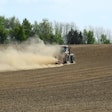
The grain industry faces myriad challenges, including land usage issues and labor shortages, but has also seen significant strides in areas like supply chain and transportation reliability, according to Mike Seyfert, president & CEO of National Grain and Feed Association.
Elise Schafer, editor of Feed & Grain, had the opportunity to sit down with Seyfert at the 127th Country Elevator Conference, held December 3-5, 2023 in Louisiville, Kentucky. Seyfert highlighted how the association is cooperating with Class I railroads, working to level the playing field for North American feed manufacturers and evolving to meet its members’ needs.
Elise Schafer, editor of Feed & Grain: What are the top challenges your members have reported over the past 12 months, and how will NGFA address those going into 2024?
Mike Seyfert, president and CEO of NGFA: Obviously there's a lot of talk regarding the Farm Bill and those federal policies, but one thing we’re hearing, even more so at the state level than the federal level, is large tracts of land being used for solar. We've had topics like this in the past from CRP conservation. We don't have a specific proposal or policy on solar necessarily yet, but that's certainly something we're hearing more about.
Labor continues to be an issue we hear about. We’ve got the H-2A temporary agricultural program and labor issues as a topic here for 2023 Country Elevator Conference.
Transportation is always a top issue. We're in much better shape, from what I’m hearing from our members, than we were 12 to 18 months ago. Rail seems to be doing better, not that there aren’t issues here and there, but we seem to be in a better spot there, as well with trucking.
Obviously, the Mississippi River has been a challenge for the waterways system. We're hearing two things from our members. Exports are down in general so less is going down the river. While that's not necessarily good, the Army Corps of Engineers saw this coming, so they're doing more dredging. We also saw a strike on the Canadian side get worked out on the St. Lawrence River.
The big issue we are watching is the Columbia Snake River and some proposals to remove or breach the dams there. A big proposal was leaked this week that, as part of the mediation process, the White House has negotiated with some tribal governments that would appear to lay the groundwork for making a case for breaching the dams. That's a major concern to our membership because it impacts the transportation system, and not just members in the PNW, but back into the interior and the export flows and markets.
And there are a number of OSHA issues that we're watching related to heat illness and walk around rules that could impact the membership.
Right now, we are working with others to push legislation up on the Hill called the IFEED Act, which would allow use of some feed ingredients that are not animal drugs, but do have some nutritional qualities that reduce methane or improve digestibility. A lot of them are currently regulated as drugs and there is a significant timeline for approval, particularly compared to other areas of the world like the EU and South America. We’re trying to put the North American feed market on a more level footing with the international marketplace.
Those are the key topics we've focused on from a policy perspective and what we're hearing from our membership over the last year.
Schafer: What USDA programs that impact your members is NGFA hoping to see funded in the next Farm Bill?
Seyfert: There are always a couple specific areas of the Farm Bill that are important to our members. The conservation title is one. Our NGFA members strongly support conservation and understand the importance of those programs. But we've always focused more on the working lands programs, not the land idling programs, and we've made progress. There's some legislation on reforms to the Conservation Reserve Program (CRP), how to bring land out of production or put it more focused on grasslands rather than productive land, and a focus more on additional acreage in those working lands programs.
Secondly, we want to maintain a Decoupled Farm Program. We feel there aren’t any proposals to change that in Congress, and the commodity program and crop insurance safety net doesn't impact our members as much, but it does impact our members’ customers. We have co-ops, too, and so we want to see those programs maintained.
We also support increasing funding for the Market Access Program (MAP) and the Foreign Market Development (FMD) Program on the export side, if additional funding is available. Those programs have been fairly static in funding since they were created and obviously the cost of administering the programs and the value you get for the dollar has changed over time. Taking a look at that and realizing there's limited resources, Sec. Vilsack recently announced some creative ways to use Commodity Credit Corporation (CCC) funds at USDA to address those funding issues for other programs. We applaud those actions by USDA and Sec. Vilsack and we think it will pay dividends, as well.
Schafer: Supply chain disruptions have played a dominant role for the past three years. Are your members seeing a return to steadier supply chains?
Seyfert: I think so, because of two factors. One is the US has been less competitive in the export market in recent months, so there's not as much volume moving. Freight overall, the economy on rail and trucking, is down. But also you've seen, particularly on the rail side, a concerted effort on our part and on the part of the Class I railroads to have a dialogue and real conversations.
We've visited a lot with them in the last year and it's been a two-way street. Certain aspects would have gone to the Surface Transportation Board (STB) at one point in time, but now we're sitting down to try and figure it out. There are a couple of topics that you probably would have heard about in the press in years prior, but you haven't heard about them this year because we were able to call and give them a head’s up or they called and gave us a head’s up to work through it. Not that there aren't areas we won’t have different points of view. There are still areas that can be challenging, but as a whole, rail and trucking are in a better spot than they were a year ago.
Schafer: The NGFA recently announced the restructuring of its committee structure. Can you elaborate on those changes and what led to them?
Seyfert: Every five years, NGFA does a long-range or strategic plan, which is overseen by an appointed committee taskforce that the Board of Directors approves. This involves outlining objectives, areas that we need to focus more on and develop more than we have in the past. Out of that long-range plan we recognized that, while we’re doing a lot of good, the industry has also changed and we haven't taken a critical look at our committees for a number of years — really, decades.
We hadn't thoroughly examined whether we have the right committees or are focused on the right areas in terms of our committee structure. That came out of our long-range plan that was approved in March of 2022 by our Board of Directors.
This past spring, our current Chairman Greg Beck from CGB appointed a task force to take that top-to-bottom look, and ultimately, decided to retire the finance and administration committee because its focus was already covered by other committees. We also realized that international trade is a huge issue, but a lot of our trade issues are tied with technology on the crop tech side, and so we combined those two. We’re also putting more of a legislative/Capitol Hill focus on our legislative and policy committee that used to be combined with trade.
Then we established two new committees. Sustainability is a big topic of conversation throughout the chain. We've had a taskforce on sustainability for the last couple of years, and there’s a feeling that this topic is going to continue to be discussed, so it'll become a full committee.
And we discussed how we can continue to offer return on investment to our members. We’re looking at whether there are new ways we can communicate and get information out to our membership, so you're going to see a new membership and communications committee to focus on those member contacts in development.
Beyond that, letting our membership know not only what our committees are, but how to get involved, is key — how they can apply for a committee, express interest in being involved in a committee, and be selected for a committee. Many of our committees will not see any changes, but there were areas it was clear we needed to make some tweaks due to industry changes and new challenges.
Schafer: How will the newly established sustainability committee help advance sustainability policies that benefit NGFA members?
Seyfert: I don't see it so much as a policy-driven committee as a committee to explore the questions we're hearing from our members to determine what kind of resources we can provide for them. Some of our members already have a good grasp on sustainability from their viewpoint and want to provide helpful resources to other companies that may still be trying to figure it out.
Not to say there won't be any policy proposals or topics that come up in the committee that end up being addressed by or sent to one of our policy committees, but right now, based on feedback received from our executive committee and our board, I see it more as a member benefit committee.
NGFA has such a broad membership that it's hard to develop a one-size-fits-all proposal or policy. Our member companies are large, small, medium, and are focused on discussing the issues, but what they're looking for and trying to do is in some instances driven by their size. It's also driven by the segment of the industry they're in.
Now, NGFA does have a policy that we think these activities should be voluntary and more market driven. We don't want to see government mandates along these lines, but we do see good reasons for USDA to research the area of sustainability.


















